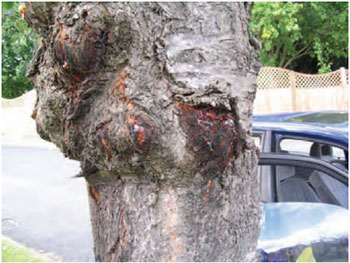Bacteria
Content
These minute organisms (see Figure 15.2) measure about 0.001 mm and occur as single cells that divide rapidly. They are important in the conversion of soil organic matter (see Soil organic matter), but may, in a few parasitic species, cause serious damage or losses to horticultural plants. Some details of their classification are given in Classification and naming. Fireblight (Erwinia amylovora) Damage: This disease, which first appeared in the British Isles in 1957, can cause serious damage on members of the Rosaceae family. Individual branches wilt and the leaves rapidly turn a ‘burnt’ chestnut brown. When the disease reaches the main trunk, it spreads to other branches and may cause death of the tree within six weeks of first infection, the general appearance resembles a burnt tree, hence the name of the disease. Badly infected plants produce a bacterial slime on the outside of the branches in humid weather. On slicing through an infected stem, a brown stain will often be seen. Pears, hawthorn and Cotoneaster are commonly attacked, while apples and Pyracantha suffer less commonly. Life cycle and spread: The bacterium is spread by bees as they pollinate, by harmful insects such as aphids and by small droplets of rain. Humid conditions and temperatures in excess of 18°C, which occur from June to September, favour the spread. Natural plant openings such as stomata and lenticels are common sites for infection. Flowers are the main entry point of entry in pears. The bacterial slime mentioned above is an important source of further infections. Fireblight, once notifiable nationally, must now be reported only in fruit-growing areas. Control: The compulsory removal of the susceptible ‘Laxton’s Superb’ pear cultivar in the 1960s eliminated a serious source of infection. Preventative measures such as removal of badly infected plants to prevent further infection, and removal of hawthorn hedges close to pear orchards, help in control. Careful pruning, 60 cm below the stained wood of early infection, may save a tree from the disease. Wounds should be sealed with protective paint, and pruning implements should be sterilized with 3 per cent lysol.
Damage: This disease affects the plant genus Prunus that includes ornamental species, plum, cherry, peach and apricot. Symptoms typically appear on the stem as a swollen area exuding a light brown gum (see Figure 15.18). The angle between branches is the most common site for the disease. Severe infections girdling the stems cause death of tissues above the infection, and the resulting brown foliage can resemble the damage caused by fireblight. In May and June, leaves may become infected; dark brown leaf spots 2 mm across develop and the infected area may be blown out by heavy winds to give a ‘shot-hole’ effect. Life cycle and spread: The bacteria present in the cankers are mainly carried by wind-blown rain droplets, infecting leaf scars and pruning wounds in autumn and young developing leaves in summer. Control: Preventative control involves the use of resistant rootstocks and scions, e.g. in plums. The careful cutting out of infected tissue followed by an application of paint and the use of autumn sprays of a copper compound (Bordeaux mixture), help reduce this disease. Soft rot (Erwinia carotovora) This bacterium affects stored potatoes, carrots, bulbs and iris, where the bacterium’s ability to dissolve the cell walls of the plant results in a mushy soft rot. High temperatures and humidity caused by poor ventilation promote infection through lenticels, and major losses may occur. A related strain of this bacterium causes black leg on potatoes in the field. Preventative control measures are important. Crops should be damaged as little as possible when harvesting, and diseased or damaged specimens should be removed before storage. Hot, humid conditions should be avoided in store. No curative measures are available. Crown gall (Agrobacterium tumifasciens) This bacterium affects apples, grapes, peaches, roses, Euonymus and many herbaceous plants. The disease is first seen just above ground level as a swollen, cancer-like structure (often about 5 cm in size) growing out of the stem. It may occasionally cause serious damage, but usually is not a very important problem. The bacterium is able to survive well in soils, and infects the plant through small wounds in the roots. It is of special scientific interest in the area of plant breeding, having the ability to add its genetic information to that of the plant cell. It does this by means of a small unit of DNA called a ‘ plasmid ’ . This plasmid ability of A. tumifasciens has been harnessed by plant breeders to transfer genetic information between unrelated plant species. It is the properties of this bacterium that have led to the new term ‘ genetically modified crop ’ or more simply ‘GM’ (see Pollination and fertilization). Control of crown gall depends on cultural control methods, such as disease-free propagating material, avoiding wounds at planting time and budding scions to rootstocks (rather than grafting) to avoid injuries near the soil level. |
||||||||||||||||||||||||||





